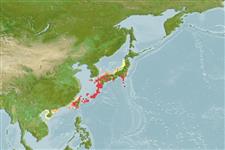Классификация / Names
народные названия | синонимы | Catalog of Fishes(род, виды) | ITIS | CoL | WoRMS | Cloffa
>
Kurtiformes (Nurseryfishes, cardinalfishes.) >
Apogonidae (Cardinalfishes) > Apogoninae
Etymology: Siphamia: A Swazi word, siphama, for a fish; senoui: This species is named senoui in honour of Dr. Hiroshi Senou of the Kanagawa Prefectural Museum of Natural History. Dr. Senou, in collaboration with various Japanese colleagues, has been largely responsible for a marked increase in our knowledge of tropical reef fishes occurring in southern Japan and the adjacent Ryukyu Archipelago. He also collected and photographed the holotype and most paratypes of this species. (Ref. 90035).
Eponymy: Dr Hiroshi Senou of the Division of Fishes, Kanagawa Prefectural Museum of Natural History, has been a leader in the drive to find more about the tropical reef fishes occurring in southern Japan and the adjacent Ryukyu Archipelago. [...] (Ref. 128868), visit book page.
Environment: milieu / climate zone / пределы глубины / distribution range
экология
морской донно-пелагический; пределы глубины 10 - 35 m (Ref. 90035). Tropical
Pacific Ocean: Japan (Ref. 90035)
Size / Вес / Возраст
половая зрелость: Lm ? range ? - ? cm
Max length : 1.9 cm SL (female)
Краткое описание
определительные ключи | морфология | морфометрия
Dorsal rays VII+I,9; anal rays II,8; pectoral rays 12 (rarely 11 or 13); tubed lateral-line scales 3-8; median predorsal scales 4-5; total gill rakers 3-4 + 9-11 = 12-14; developed gill rakers 1-2 + 8-9; gill rakers on ceratobranchial 6-7. Body depth 2.3-2.7 in SL and body width 1.95-2.25 in the depth; eye diameter 2.65-3.1 in head length; first dorsal spine 2.3-10.3 in second spine; second dorsal spine 4.35-6.2, spine of second dorsal fin 3.5-4.4,and second anal spine 4.7-5.6, all in head length; pectoral-fin length 4.4-4.95 and pelvic-fin length 4.1-4.9 in SL;caudal-peduncle length 1.1-1.5 in distance between pelvic spine insertion and anal-fin origin. Preopercular edgeweakly serrate around angle, with 4-15 (usually 7-12) minute serrations; preopercular ridge smooth. Tip of light organon each side of tongue bound by membrane (Ref. 90035).
Body shape (shape guide): short and / or deep.
Life cycle and mating behavior
половая зрелость | размножение | нерест | икра | Fecundity | личинки
Gon, O. and G.R. Allen, 2012. Revision of the Indo-Pacific cardinalfish genus Siphamia (Perciformes: Apogonidae). Zootaxa 3294:1-84. (Ref. 90035)
Статус Красного Списка МСОП (Ref. 130435: Version 2025-1)
Угроза для людей
Harmless
Использование человеком
дополнительная информация
инструменты
Специальные отчеты
Скачать в формате XML
ресурсы в Интернет
Estimates based on models
Phylogenetic diversity index (ссылка
82804): PD
50 = 0.5000 [Uniqueness, from 0.5 = low to 2.0 = high].
Bayesian length-weight: a=0.01445 (0.00680 - 0.03071), b=3.07 (2.89 - 3.25), in cm total length, based on LWR estimates for this (Sub)family-body shape (Ref.
93245).
Trophic level (ссылка
69278): 3.0 ±0.4 se; based on size and trophs of closest relatives
устойчивость к внешним воздействиям (ссылка
120179): высокий, минимальное время удвоения популяции до 15 месяцев (Preliminary K or Fecundity.).
Fishing Vulnerability (Ref.
59153): Low vulnerability (10 of 100).
🛈
